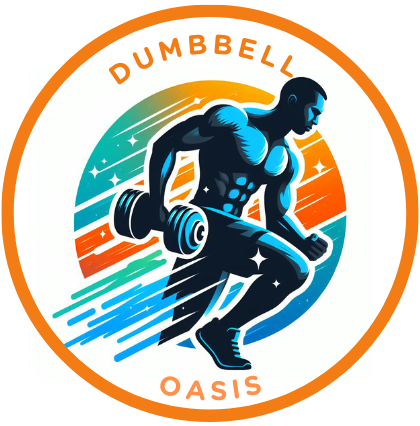Dumbbell History And Evolution
Please, allow me (Eric) to take you way back, starting with the ancient Greeks. Did you know the earliest dumbbells were called ‘halteres’? These were used not just for strength training, but also in long jump competitions – pretty versatile, right?
The design of dumbbells has changed dramatically. We’ve gone from halteres to the more familiar dumbbell shape we see today. In the 17th century, the term ‘dumb bell’ referred to a device that mimicked the action of ringing a bell, but without the sound – hence ‘dumb’.

Important figures? Oh, there were quite a few. For instance, Eugen Sandow, the father of modern bodybuilding, helped to popularize dumbbell exercises in the late 19th century. He also influenced the shift from blocky shapes to the refined, plate-loaded versions.

By the time the 20th century rolled around, dumbbells were common in gyms. The introduction of adjustable and fixed-weight dumbbells offered people a variety of training options, contributing to their popularity in physical culture.
This isn’t just about the weight; it’s about the legacy. From sandbag-like implements to precision-engineered tools, dumbbells have become key in any strength routine, embodying a history of human fitness and innovation.
The Undeniable Appeal: Why Dumbbells Remain a Fitness Staple
I’m going to break down why dumbbells have been a go-to exercise tool for so long. This isn’t just about tradition; it’s also about the impressive flexibility that dumbbells offer. Whether you’re aiming for strength, endurance, or hypertrophy, dumbbells come through with flying colors. You’re going to find out about their inherent versatility that makes them suitable for a wide range of exercises, allowing both compound and isolation movements. This flexibility is a huge win for those looking to tailor their workouts to specific goals.
Beyond the muscle fibers, there’s an interesting psychological effect. When you lift, you’re not only strengthening your body; you’re also empowering your mind. That sense of accomplishment after hoisting heavier weights over time builds confidence. It’s a mental game as much as it is physical, and dumbbells have been at the core of this journey for many athletes.
Now, how does the humble dumbbell stack up against other popular gym equipment? You’ll be intrigued to know that compared to fixed machines, dumbbells activate more stabilizer muscles, leading to balanced muscle growth and reduced injury risk. This is why personal trainers and coaches often incorporate them into training programs – they’re just that effective.

And let’s talk about the people who’ve seen real change thanks to these cast-iron tools. Fitness enthusiasts from athletes to celebrities often credit dumbbells for their transformed physiques. With endorsements from those leading healthy lifestyles, it’s clear to see why dumbbells have retained their position in the halls of fitness fame.
In my opinion, what cements dumbbells as a top choice is their incredible adaptability to various workout styles. Whether you want to increase muscular strength, enhance muscular endurance, or build that coveted muscle definition, dumbbells are there to facilitate your journey. With that said, let’s pivot to who’s actually using them and how they measure up to other pieces of fitness equipment.
Dumbbells in Numbers: Who’s Lifting and How They Compare
Now, I’m going to show you how prevalent dumbbell use is, and trust me, the numbers speak volumes. Let’s start with who’s actually lifting these handy weights. Recent surveys have highlighted a surge in dumbbell popularity across all genders, with an impressive increase in female lifters. But it’s not just about gender; age demographics are getting broader too, with both younger and older adults picking up the weights.
If you’re curious about the workout preferences, you’ll find out about the usage patterns indicating a strong preference for dumbbells over machines for their simplicity and effectiveness. There’s a preference for free weights in individuals seeking functional strength and full-body conditioning, whereas machines often appeal to those targeting specific muscle groups.
Statistics show a notable trend: while men still dominate the free-weight sections, women are rapidly closing the gap, thanks to increased awareness and empowering fitness movements. This shift is transforming gym cultures and debunking long-standing myths about women and weightlifting.
When it comes to the economics of fitness, dumbbells win hands down for most. They’re not only more cost-effective compared to pricey gym memberships and bulky home gym setups but also offer an excellent price-to-utility ratio.

They’re a one-time purchase that can serve a lifetime of workouts, transcending the temporary allure of trendy fitness gadgets.
The Future Weighs In: Evolving Dumbbell Technology and Usage
I’m going to paint you a picture of where dumbbells could be heading in the future. It’s not just a simple weight with a handle anymore; it’s becoming a sophisticated piece of technology. Imagine smart dumbbells equipped with sensors that track your every lift, set, and rep. They might even give you feedback on form and suggest workouts tailored to your goals.
Now what is this untapped potential I’m hinting at? It’s about harnessing technology to make workouts more interactive and productive. We already have apps for tracking, social elements to keep us engaged, and now the integration with our weights is a natural next step. Choices that resonate with tech-savvy lifters could redefine at-home workouts and gym experiences alike.

You might wonder if these advancements will sideline the classic dumbbell, but in my opinion, there’s no replacement for the simple effectiveness of iron and gravity. However, the blend of old and new school–where craftsmanship meets tech–that’s where the opportunity lies. Companies are starting to tease the market with smart weights, and this is just the beginning.
There’s a lot happening very quickly in the world of fitness tech. From virtual reality workout games to AI personal trainers, dumbbells will undoubtedly play a role in this technological revolution, evolving as needed to fit into these innovative workout systems. So my question to you today is, are you ready to lift the dumbbells of the future?
Now that you’re familiar with the fascinating history and evolution of dumbbells, let’s dive into the fundamentals: Dumbbells Exercises for Beginners.
